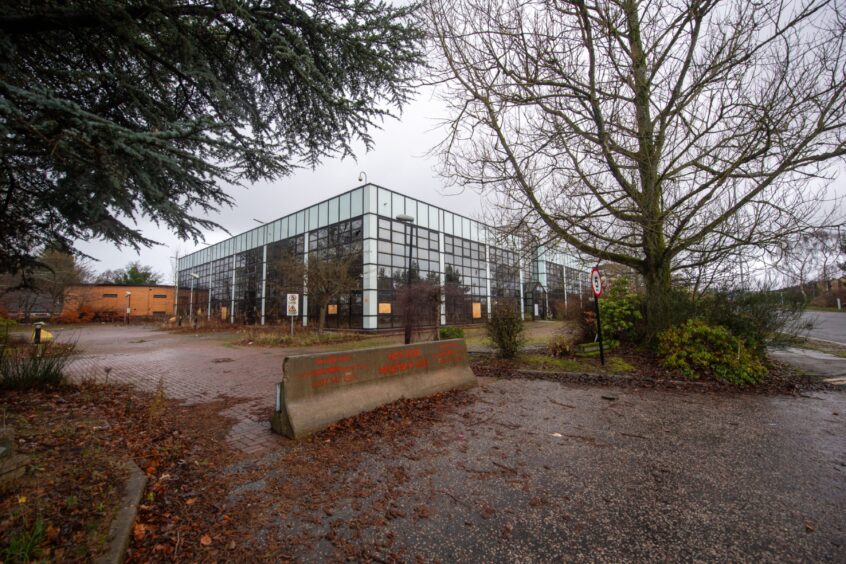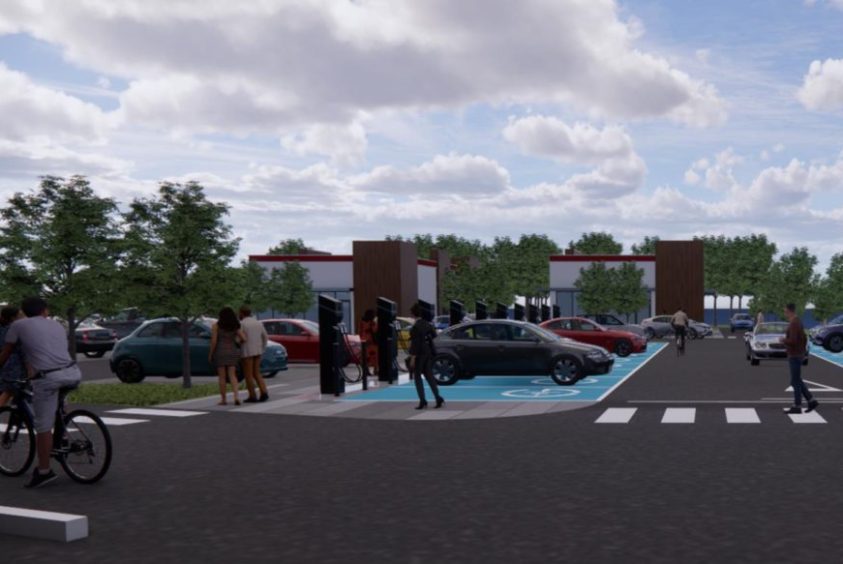
A former Aberdeen oil HQ could be bulldozed to make way for what might be Scotland’s largest electric vehicle charging station.
Housing plans for the long-mothballed Alba Gate building were approved in late 2020.
Now owner CoCity claims residential development is unviable due to soaring construction costs.
Instead, they want to raze the “big ugly greenhouse” across the road from BP’s North Sea HQ and build a hub of 26 fast DC chargers in its place at the Stoneywood Gate site.
The plans, revealed by The Press & Journal on Friday, also include slower AC chargers, light industrial units and two restaurants.
CoCity claims there is already interest in the commercial premises, promising a jobs boost for Stoneywood.
But what would be the north-east’s largest fast charging station might be felled by similarly fast food.
Whether those two diners are drive-thru or drive-to makes the road ahead “ambiguous” for the key transport infrastructure project…
Drive-thru or drive-to: What’s the difference?
Scottish ministers brought in new planning rules earlier this year.
The new framework, known as NPF4, puts “almost a hard stop” on drive-thru restaurants, CoCity’s Pete Craig claims.
From now on, drive-thru plans should only be approved for certain preordained sites.
The trouble, Pete and his north-east architecture consultant Rich Tinto add, is that there are none of those in Aberdeen’s refreshed guidelines approved in June.
And that could be a dealbreaker for the major EV charging firm that has already agreed heads of terms with CoCity to provide the region’s largest collection of fast chargers on the disused site.
Only this week, Aberdeenshire Council approved plans for a drive-thru coffee shop along with roadside EV charging outside Stonehaven on the A90 Aberdeen bypass.
And plans for drive-thru Starbucks and McDonald’s restaurants, again with EV charging, are expected to be given the nod at Huntly, off the A96 Aberdeen to Inverness road.
Stoneywood Gate dealbreaker: Charging tsars demand facilities
Even with the fast chargers proposed for the site, most recently the base for Helix Offshore, motorists will still be spending 30 minutes as a minimum as their cars juice up.
The site could be “strategically important” in the shift to having more electric vehicles on the roads, providing zip for commuters traveling into Aberdeen from the north.
Tinto Architecture director Rich adds: “The charging infrastructure providers have a real requirement for people to stop and use facilities.
“There is a gap between NPF4 and the Aberdeen local development plan which could jeopardise the provision of Scotland’s largest EV charging station.
“In order to bring this to Aberdeen, the companies investing in infrastructure need drive-to or drive-thru places to allow those stopping to charge their cars to refuel themselves too.
“The question is… how brave are the city council going to be with regards to understanding that requirement and acknowledging the gap in their own LDP?”
Stoneywood Gate site no stranger to controversy
Alba Gate, and the existing housing plans, already caused controversy.
CoCity had to take their fight to the Scottish Government to win the right to be able to sell the flats they planned to build.
Aberdeen City Council had initially imposed a build-to-rent restriction on the development. The Scottish Government overruled the local authority.
When residential use became unworkable, CoCity also looked at bringing the offices back into use.
But their property agents FG Burnett and Shepherd steered them away from that, citing an overprovision of office space already in Aberdeen.
While they’ve weighed up the options, vandals have being drawn to the shimmering glass beacon.
Not content with smashing its many windows, there have been attempts to start fires inside too.
“It’s getting more and more dilapidated,” Pete says.
“Local youths have basically demolished the inside of the building. It’s becoming an eyesore.”
The plans could play into Aberdeen City Council’s pledge to lead the way in bringing EV charging infrastructure.
Having a private investor willing to pay for it could reduce the burden on the cash-strapped local authority too.
In 2020, there were 13 fast chargers in Aberdeen. By 2025, city chiefs want at least 25.
But the “ambiguity” between national and local planning rules could threaten that prospect, CoCity claims.
Rich tells us: “Planners are almost hamstrung to a point of refusal because their own local development plans and policies are not aligned with NPF4.
“And that gives companies like CoCity a real headache when they’re trying to bring these things forward.
“This is going to be contentious and a bit of a test case.
“We fully expect to get a recommendation for refusal on these plans, to go before the planning committee, and to have stand up and convince councillors that the positives far outweigh the negatives.
“NPF4 is probably the biggest change to planning guidance in a generation and its drive for sustainability are welcome, merited and absolutely what we should be doing.
“But the question is, can Aberdeen lead the way with helping to facilitate this type of thing.
“Is the council cognisant of planning frustrations and are they brave enough to say the greater good is more important?”
Recommended for you

 © Supplied by CoCity/Tinto Archite
© Supplied by CoCity/Tinto Archite